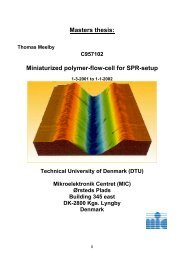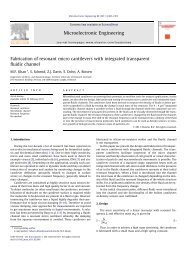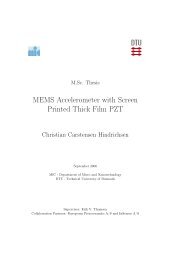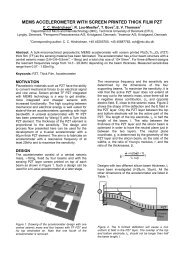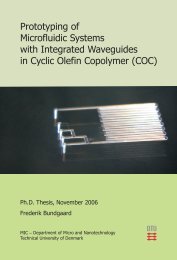C - DTU Nanotech - Danmarks Tekniske Universitet
C - DTU Nanotech - Danmarks Tekniske Universitet
C - DTU Nanotech - Danmarks Tekniske Universitet
Create successful ePaper yourself
Turn your PDF publications into a flip-book with our unique Google optimized e-Paper software.
24 4 Basic Principles of a Peltier Element<br />
α = Seebeck coefficient<br />
T = Temperature<br />
Due to the heat transfer when a temperature gradient is set up across both sides of the<br />
junction, thermal conductivity acts to reduce the temperature gradient. This means that<br />
the ideal materials A and B need to have a high electrical and a low thermal conductivity.<br />
The high Peltier coefficient ΠAB of semiconductors enables the construction of convenient<br />
Peltier elements, because they have a good electrical-to-thermal conductivity ratio. The<br />
cooling element consists of alternating p–endowed semiconductor (Π > 0) and a n–endowed<br />
semiconductor (Π < 0) which are connected electrically in series by thin junctions and<br />
thermally in parallel between two ceramic substrates [25] (illustrated in Fig. 4.1). In the<br />
endowing process atoms from another element are inserted to a semiconductor crystal to<br />
change the conductivity of the semiconductor. These inserted charge carriers can have a<br />
negative charge or a positive charge, dependent on the material which is used for the endow-<br />
ing process. Semiconductors which are endowed with negative charge carriers are n–endowed<br />
and have consequently free movable electrons. These, which have been endowed with posi-<br />
tive charge carriers are called p–endowed and thus have holes. For further readings on the<br />
subject of semiconductors, I refer to [10] and also for the subject of Peltier cooling to [12].<br />
The advantages of Peltier elements are their small size, the absence of wear and their silent<br />
running. They are often used in the following systems or because of following reasons:<br />
• Micro–constructions of cooling or heating systems<br />
• Heat transfer to hermetical closed cabinets<br />
• Spot cooling or heating<br />
• Temperature stabilization<br />
• Compensation of heat flow<br />
• Mobile application because of their light weight<br />
• Long–life<br />
• For fast and dynamic response<br />
• No moving parts, therefore they require little or no maintenance, ideal for cooling parts<br />
that may be sensitive to mechanical vibration<br />
• No refrigerants, such as potentially harmful CFCs, therefore environmental and safety<br />
benefits



